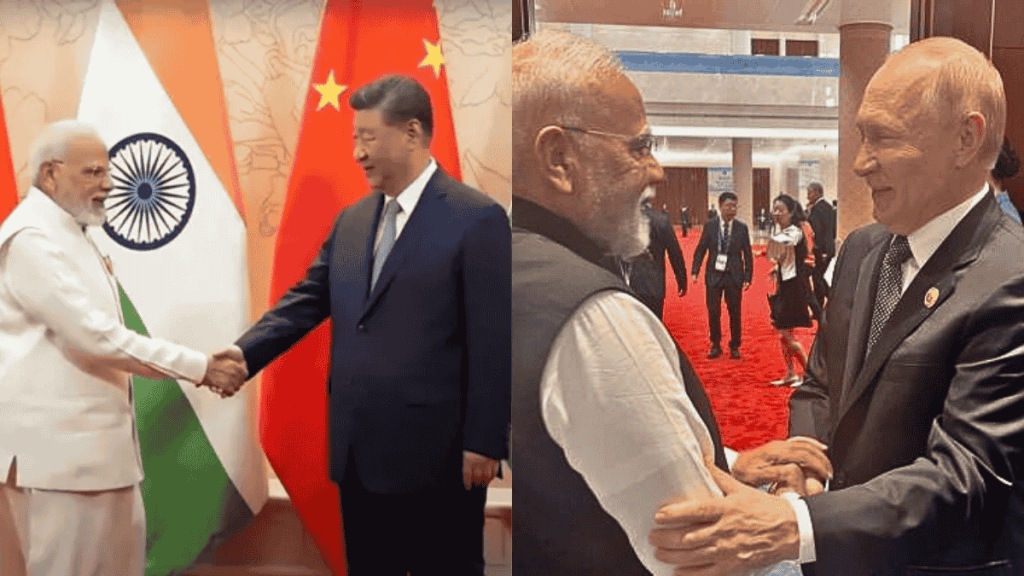“We are now in the post-American trade leadership era, maybe even the post-American leadership era,” states Dr Richard Baldwin while speaking at India Dialogue 2025 according to Elara Capital, who predicts a long-term structural shift in global trade after Trump’s disruptive trade rhetoric.
The troika of the new world order was visible at the SCO Summit in Tianjin which saw Prime Minister Modi in a huddle with Vladimir Putin and Xi Jinping. All thanks to Donald Trump who magnetised the three world powers to join hands against the Trump induced tariffs and sanctions.
India and China resetting trade ties amid US tariff
India and China, once at odds due to border tensions, are now working towards improving their trade relations. However, India and the US, who used to call each other “old friends,” are now at odds after Trump singled out the country for Russian oil purchase and stalemate during the trade negotiations.
With Trump’s steep tariffs in place, BRICS nations are now looking to move beyond the US and realign previous relationships to check export challenges. India and China are seeking to reset their trade ties, while Russia is extending support, as seen during the SCO Summit.
China may be a better alternative for Asian countries however, Baldwin added that no single country can replace the US. “Instead, new coalitions will form, and old ones will expand. The world is heading towards re-globalisation just without the United States.”
Analysts warns of persistent trade challenges with China
The bilateral trade between India and China has grown over the years, with China topping India’s import list. In FY25, the bilateral trade between the two countries reached $127.71 billion, with India’s imports at $113.46 billion and exports at $14.25 billion (as per the Embassy of India, Beijing).
However, analysts highlight that challenges still persist even if China and India promise to work positively towards trade. Wendy Cutler, Senior Vice President at the Asia Society Policy Institute, said, “India’s large and growing bilateral goods trade deficit with China, reaching $99 billion last year, is not going away overnight and poses serious challenges to Delhi.”
India continues to need Chinese intermediate goods to grow its manufacturing base and attract foreign investment leaving China. Cutler added that high US tariffs have led China to export more to other markets, including India. “India, like Southeast Asia, is grappling with the onslaught of Chinese imports, threatening to displace local production,” she said. India has already initiated antidumping cases against certain Chinese imports and may adopt more restrictive measures.
Tariffs making India less competitive in US market
With the tariffs in place, American companies may finding India less attractive compared to other low-tariff destinations such as Vietnam and Mexico which are facing less tariff thus, cheaper than Indian products. Consumers who were looking at India as China plus one strategy will have to look for another opportunity.
India–China ties may take years to normalize: Analyst
Gaura Sengupta, Chief Economist at IDFC First Bank said, “It is difficult to see how significant the shift will be. However there could be move towards increasing trade relations and some easing of investment restriction.”
“That said given that US is the largest importer and china the largest exporter globally… the two countries play a very different role in world trade.” she added.
Gautam Bambawale, a former Indian ambassador to Beijing, said in an interview with NBC news that it could take “months, if not years” for India-China relationship to return to where it was before 2020, let alone reach new heights.
Wendy Cutler further added that India is not an isolated case, “Uncertain and restrictive US trade policy is creating strange bedfellows. We should be prepared to see more of our trading partners approach others, even those with strained relations and on matters that once seemed off the negotiating table.”
“Even countries with whom we have reached trade deals have been scarred in the process, leading them to find ways to reduce dependence on the US market,” she added.
